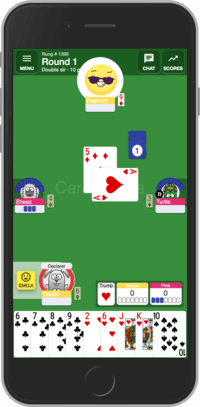Overview
Rung Court Piece is a popular trick taking game in India and Pakistan in which Teams try to be the first to win 10 points. Rung Court Piece is played with 4 to 12 players divided into two teams.
Summary
- The first team to win seven tricks wins the round
- Declarer picks a suit after everyone is dealt five cards
- Simple Scoring: Trump-caller's team scores 1 point if they win the round, and 3 points for a court. Opposing team scores 2 points if they win, and 4 points for a court
- Courts Scoring: Trump calling team score 1 point on court and opposing team score 3. Furthermore, winning 7 rounds in a row scores a 'court'
Presets
- Single Sir / Single Sar: Tricks are claimed immediately
- Double Sir / Double Sar: When a player wins a trick, they do not immediately claim it. Instead, won tricks are set aside until one player wins two consecutive tricks, at which point they claim all tricks currently set aside
- Hidden Rung / Hidden Trump / Dub Rung As Double Sir, except the declarer selects one card from their first five cards to be the 'hidden rung'. Its suit is the trump suit, but the card is not revealed to the other players until the declarer chooses to reveal it at the start of the round or when an opponent cannot follow suit and asks for the trump to be revealed, allowing them to play trump cards. Tricks cannot be claimed until the trump suit is revealed. Be-ranga Double Sar can also be played in which there is no trump caller in the beginning and first out of suit card played becomes the trump
Play Multiplayer Rung Court Piece Online
The Deck and the Deal
Rung Court Piece is played with a standard deck of 52 playing cards. Cards are dealt in three stages. First, only five cards are dealt to each player. Then, the player selected as the declarer, or trump-caller, chooses the trump suit (called the eldest hand). Finally, the rest of the deck is dealt to give each player a full hand of cards.
For 4, 8, and 12 players, 13 cards are dealt for a full hand; For 6 players, 16 cards are dealt for a full hand; For 10 players, 15 cards are dealt for a full hand.
1 deck is used with 4 players; 2 decks are used with up to 8 players; 3 decks are used with up to 12 players.
With 6 players, 2s are removed from the decks; with 10 players, two 2 of Clubs, two 2 of Diamonds, one 2 of Hearts and one 2 of Spades are removed from the decks.
No matter the amount of decks used, players must always win a majority of tricks than the other team.
How to Play
Trick-taking follows the standard rules.
To win a round in a 4 player game, the team must win at least seven out of thirteen tricks. A team can also score a 'court' - either by winning the first seven tricks in a round (thus winning the round), or by winning 7 rounds in a row. A court is worth additional bonus points.
One member of the losing team becomes the dealer for the next round. If the previous dealer's team won, the player to the dealer's right becomes the new dealer. If the dealer's team loses, but their opponents do not score a court, then the dealer does not change. If their opponents do score a court, the previous dealer's partner becomes the new dealer.
Scoring
There are two scoring options:
- Simple: If the trump-caller's team wins the round, they score 1 point and 2 additional points for a court. If the opposing team wins, they score 2 points and similarly 2 additional points for a court
- Courts: Teams only score points for courts. The trump-calling team scores 1 point for a court, while the opposing team scores 3 points for a goon court
Winning
The first team to reach 10 points wins the game. The target score can also be set to 5, 15 or 20 points.
Variations
CardzMania supports several customizable rules and options so you can play Rung Court Piece exactly how you like or how you grew up playing with your friends and family. In addition to the classic way of playing, we often have new creative options for you to try to spice up the game if you are interested in trying different spins for fun.
Points
Players determine a set amount of points when the game ends.
Rounds
Players determine a set amount of rounds (also known as hands or deals) that the game will go to (instead of the points selection above).
Timer
Players only have a set amount of time to make their turn after which a turn is automatically played for them and the game proceeds: Fast is 7 seconds, Standard is 15 seconds, Slow is 30 seconds, and Very Slow is 60 seconds. Players can also choose to disable the timer, but that is only for private tables.
Scoring Method
The scoring method can either be Simple or Court as described above.
Redeal
When enabled, the declarer can redeal the cards if all of their dealt cards are smaller than a Jack.
Round Robin
When enabled, the declarer position rotates clockwise.
Bigger Piles
When enabled, there are bigger piles required to win the pile. At the start of the game, players need five tricks to win the pile (as opposed to three), and afterwards they need three tricks to win the pile (as opposed to two).
Ace Doesn't Win Pile (Double Sir Variation)
Under certain circumstances, winning a trick may not allow the player to win the pile. The options are:
- Disabled: Winning two tricks in a row always wins the pile
- Trump Ace: Winning a trick with a trump ace does not win the pile
- Any Ace: Winning a trick with an ace does not win the pile
- Ace on Ace: Winning two consecutive tricks with aces does not win the pile
No trumps
When enabled, no trumps is allowed during trump making (in addition to the four suits)
Anyone's Trump / Be-ranga double sir / Be-ranga double sar / Blind rung
When enabled, the first out of suit card played becomes the trump. In this variation, the dealer deals all thirteen cards to everyone and there is no trump caller. Trick taking proceeds as normal without trump until someone cannot follow suit. When someone is unable to follow suit and plays an out of suit card, that card becomes the trump.
Show Declarer Discards
This variation is only available when playing hidden rung. When enabled, the declarer must show the non-suit cards they discard. By default, it's disabled, which means the declarer's out-of-suit discards are not visible for other players; they are discarded upside down so other players can't get hints on the hidden trump.
First card wins
When enabled, the first card wins if two of the same cards are played (as opposed to the second card). This is relevant when using two or more decks.
Rung Court Piece Strategy
Rung Court Piece, a trick taking card game is played in fixed partnerships, very popular in India and Pakistan. Rung Court Piece is urdu for color, which refers to the trump suit - any trump card i.e card of the suit beats other suit cards. Sir means trick in urdu and therefore single sir / single sar refers to single tricks while in double sir / double sar one person has to win two consecutive tricks. The dealer deals five cards to everyone first and the player sitting after the dealer (known as the eldest hand or elder hand) gets to call the trump after all cards dealt - trump caller. The players in fixed partnership sit across each other. Dealers team has the disadvantage of not calling the trump while the trump callers team of course has that advantage.
Trick Basics
Trick Taking games center around having the highest ranked card in a draw. Typically, players of trick taking games sit in a circle, sometimes in teams and sometimes playing solo, and are dealt a hand of cards. Given the specific game's card ranking (and trump - special suit that beats other suits), players draw a card from their hand in hopes that it outranks the other cards played. The player who outranks the others wins the trick for that round and gameplay is repeated until the cards are exhausted. Typically the player or team with the most tricks wins the game.
In a trick, each player plays a single card. One player is selected to start, then play proceeds clockwise around the table. If possible, players must play a card which is the same suit as the first card played - this is called 'following suit'. If a player cannot follow suit, then they may play any card in their hand. Based on the cards played, one player is declared the winner of the trick, usually for playing the highest value card of the trump suit, or of the suit of the card which started the trick.
After all cards have been dealt, normal trick taking commences. Remember all cards of the suit declared as trump (trump cards) beats any other suit. Whichever team wins seven tricks out of thirteen wins the round, winning all thirteen tricks is referred to as court. If the dealers team achieves this feat, its called a goon court. In single sir, winning the first seven consecutive tricks constitutes a court.
After cards dealt, depending on the trump, you have to figure out your strategy for the game whether to play trump first or not. In single sir / single sar winning the first seven tricks constitutes as a court or a goon court, so the strategy is very different than double sir / double sar. Whichever team (dealers team or trump callers team) wins seven tricks wins the deal and the opposing team becomes the dealer. In double sir, you have to win two consecutive tricks, so the strategy is totally different as you need to keep another high card to win the pile. Note that the second and the second last trick cannot be won, so you have to be extra careful about that too. This game is played in many variations so you have to be extra careful about the rules.
Based on the cards played, one player is declared the winner of the trick, usually for playing the highest value card of the trump suit, or of the suit of the card which started the trick.
Hand
The cards that a player is dealt forms their hand. Each round, a player selects one of the cards in their hand and plays them into the pile. In most trick taking games, all players are dealt the same number of cards and the hand is hidden from the other players, but in some games, like 500, a player can reveal their hand for bonus points.
Pile
The pile is the spot where players place their chosen card for the round. The player with the highest ranked card receives all of the cards in the pile and sets them to the side. In most trick taking games, the individual cards in the pile have a specific point value that is given to the winner.
Dealer
The dealer is chosen at random and passes out the deck of cards to form each player's hand. In most games, the dealer position rotates to the left once the deck needs to be re-shuffled and re-dealt.
Trump
Arguably the most important part of any trick taking game, the trump suit is the highest ranked suit in the game. Every game has its own method of selecting trump. Some games leave the selection up to the winner of the bid while some games make the suit of the lead card the trump suit.
Order
The ranking of the cards is dependent on the game. Ace is usually considered the highest in trick games, but some games from Europe, like Klaverjassen, have the Jack of trump the highest card.
Auction/Bidding
Most trick taking games contain an auctioning/bidding phase at the beginning of gameplay. During this time, players take turns bidding how many tricks they expect to win in the game. The player with the highest bid leads the first trick and decides the trump suit in most games. Often times, if the winner of the bid, sometimes called the declarer, fails to win the amount of tricks they bidded, they receive a lot of penalty points
Lead Card
The Lead card is the first card in the trick. In most trick taking games, subsequent players need to play the suit of the lead card if they can.
Card Game Basics
A deck of cards consists of 52 cards, with 4 distinctive subgroups. Each of these subgroups is recognised by a symbol and are referred to as suits. They consist of Clubs, Spades, Hearts and Diamonds. Each suit contains 13 cards which, generally, are considered in this order, Ace (A), 2, 3, 4, 5, 6, 7, 8, 9, 10, Jacks (J), Queen (Q) and King (K). Some games include the two Jokers found in a standard deck but most games don't.
Rung Court Piece Strategy
Rung Court Piece, a trick taking card game is played in fixed partnerships, very popular in India and Pakistan. Rung Court Piece is urdu for color, which refers to the trump suit - any trump card i.e card of the suit beats other suit cards. Sir means trick in urdu and therefore single sir / single sar refers to single tricks while in double sir / double sar one person has to win two consecutive tricks. The dealer deals five cards to everyone first and the player sitting after the dealer (known as the eldest hand or elder hand) gets to call the trump after all cards dealt - trump caller. The players in fixed partnership sit across each other. Dealers team has the disadvantage of not calling the trump while the trump callers team of course has that advantage.
Trick taking basic rules: In a trick, each player plays a single card. One player is selected to start, then play proceeds clockwise around the table. If possible, players must play a card which is the same suit as the first card played - this is called 'following suit'. If a player cannot follow suit, then they may play any card in their hand. Based on the cards played, one player is declared the winner of the trick, usually for playing the highest value card of the trump suit, or of the suit of the card which started the trick.
After all cards have been dealt, normal trick taking commences. Remember all cards of the suit declared as trump (trump cards) beats any other suit. Whichever team wins seven tricks out of thirteen wins the round, winning all thirteen tricks is referred to as court. If the dealers team achieves this feat, its called a goon court. In single sir, winning the first seven consecutive tricks constitutes a court.
After cards dealt, depending on the trump, you have to figure out your strategy for the game whether to play trump first or not. In single sir / single sar winning the first seven tricks constitutes as a court or a goon court, so the strategy is very different than double sir / double sar. Whichever team (dealers team or trump callers team) wins seven tricks wins the deal and the opposing team becomes the dealer. In double sir, you have to win two consecutive tricks, so the strategy is totally different as you need to keep another high card to win the pile. Note that the second and the second last trick cannot be won, so you have to be extra careful about that too. This game is played in many variations so you have to be extra careful about the rules.
Feedback
Would like to discuss new features or variations for Rung Court Piece? Need a custom rule? Have a question? Got a suggestion? Don't see a game you want to play? Please contact us by
email, facebook or twitter - we really value your feedback and love hearing from all of you!
This site uses cookies. By continuing to browse the site you are agreeing to our use of cookies.




